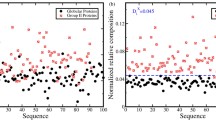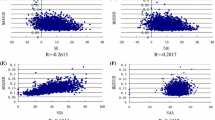Abstract
We present a new method, secondary structure prediction by deviation parameter (SSPDP) for predicting the secondary structure of proteins from amino acid sequence. Deviation parameters (DP) for amino acid singlets, doublets and triplets were computed with respect to secondary structural elements of proteins based on the dictionary of secondary structure prediction (DSSP)-generated secondary structure for 408 selected nonhomologous proteins. To the amino acid triplets which are not found in the selected dataset, a DP value of zero is assigned with respect to the secondary structural elements of proteins. The total number of parameters generated is 15,432, in the possible parameters of 25,260. Deviation parameter is complete with respect to amino acid singlets, doublets, and partially complete with respect to amino acid triplets. These generated parameters were used to predict secondary structural elements from amino acid sequence. The secondary structure predicted by our method (SSPDP) was compared with that of single sequence (NNPREDICT) and multiple sequence (PHD) methods. The average value of the percentage of prediction accuracy for αhelix by SSPDP, NNPREDICT and PHD methods was found to be 57%, 44% and 69% respectively for the proteins in the selected dataset. For Β-strand the prediction accuracy is found to be 69%, 21% and 53% respectively by SSPDP, NNPREDICT and PHD methods. This clearly indicates that the secondary structure prediction by our method is as good as PHD method but much better than NNPREDICT method.
Similar content being viewed by others
References
Chou P Y and Fasman G D 1974a Conformational parameters for amino acid in helical, Β-sheet and random coil regions calculated from proteins;Biochemistry 13 211–222
Chou P Y and Fasman G D 1974b Prediction of protein conformation;Biochemistry 13 222–245
Chou P Y and Fasman G D 1978 Prediction of the secondary structure of protein from their amino acid sequence;Adv. Enzymol. 47 45–148
Di Francesco V, Garnier J and Munson P J 1996 Improving protein secondary structure prediction with aligned homologous sequences;Protein Sci. 5 106–113
Frishman D and Argos P 1997 Seventy-five percent accuracy in protein secondary structure prediction;Proteins 27 329–335
Garnier J 1990 Protein Structure Prediction;Biochimie 72 513–524
Garnier J, Osguthorpe D J and Robson B 1978 Analysis of the accuracy and implications of simple methods for predicting the secondary structure of globular proteins;J. Mol. Biol. 120 97–120
Geourjon C and Deleage G 1994 SOPM: a self optimised prediction method for protein secondary structure prediction;Protein Eng. 7 157–160
Hobohm U, Scharif M, Schneider R and Sander C 1992 Selection of representative protein datasets;Protein Sci. 1 409–417
Kabat E A and Wu T T 1974 Further comparison of predicted and experimentally determined structure of adenylate kinase;Proc. Natl. Acad. Sci. USA 71 4217–4220
Kabsch W and Sander C 1983 Dictionary of protein secondary structure pattern—recognition of hydrogenbonded and geometrical features;Biopolymers 22 2577–2637
Kabsch W and Sander C 1984 On the use of sequence homologies to predict protein structure: identical pentapeptides can have completely different conformations;Proc. Natl. Acad. Sci. 81 1075–1078
Kneller D G, Cohen F E and Langridge R 1990 Improvements in protein secondary structure prediction by an enhanced neural network;J. Mol. Biol. 214 171–182
Levin J, Pascarella S, Argos P and Garnier J 1993 Quantification of secondary structure prediction improvement using multiple alignment;Protein Eng. 6 849–854
Lim V I 1974 Structural principles of the globular organization of proteins chains, A Stereochemical theory of globular protein secondary structure;J. Mol. Biol. 88 857–872
Mehta P K, Heringa J and Argos P 1995 A simple and fast approach to prediction of protein secondary structure prediction from aligned sequence with accuracy above 70%;Protein Sci. 4 2517–2525
Nagano K 1973 Logical analysis of the mechanism of protein folding;J. Mol. Biol. 75 401–420
Nagano K 1977a Logical analysis of the mechanism of protein folding. IV. Super-secondary structures;J. Mol. Biol. 109 235–250
Nagano K 1977b Triplet information in helix prediction applied to the analysis of super-secondary structures;J. Mol. Biol. 109 251–274
Periti P F, Quagliarotti G and Liquori A M 1967 Recognition of α-helical segments in proteins of known primary structure;J. Mol. Biol. 24 313–322
Ptitsyn O B and Finkelstein A V 1983 Theory of protein secondary structure and algorithm of its prediction;Biopolymers 22 15–25
Rost B and Sander C 1993 Prediction of protein secondary structure at better than 70% accuracy;J. Mol. Biol. 232 584–599
Rost B and Sander C 1994 Combining evolutionary information and neural networks to predict protein secondary structure;Proteins 19 55–72
Rost B, Sander C and Schneider R 1994 PHD-an automatic mail server for protein secondary structure prediction;Comput.Appl. Biosci. 10 53–60
Salamov A A and Solovyev V V 1995 Prediction of protein secondary structure by combining nearest-neighbor algorithms and multiply sequence alignment;J. Mol. Biol. 247 11–15
Solovyev V V and Salamov A A 1994 Predicting alpha-helix and beta-strand segments of globular proteins;Comput. Appl. Biosci. 10 661–669
Veluraja K and Mugilan S A 1997 Amino acid doublets and triplets in protein sequences—A database analysis;Curr. Sci. 72 572–577
Wu T T and Kabat E A 1973 An attempt to evaluate the influence of neighboring amino acids (n-1) and (n + 1) on the backbone conformation of amino acid (n) in proteins. Use in predicting the three-dimensional structure of the polypeptide backbone of other proteins;J. Mol. Biol. 75 13–31
Zvelebil M J, Barton G J, Taylor W R and Sternberg M J 1987 Prediction of protein secondary structure and active sites using the alignment of homologous sequences;J. Mol. Biol. 195 957–961
Author information
Authors and Affiliations
Corresponding author
Rights and permissions
About this article
Cite this article
Mugilan, S.A., Veluraja, K. Generation of deviation parameters for amino acid singlets, doublets and triplets from three-dimensional structures of proteins and its implications for secondary structure prediction from amino acid sequences. J. Biosci. 25, 81–90 (2000). https://doi.org/10.1007/BF02985185
Received:
Accepted:
Published:
Issue Date:
DOI: https://doi.org/10.1007/BF02985185




